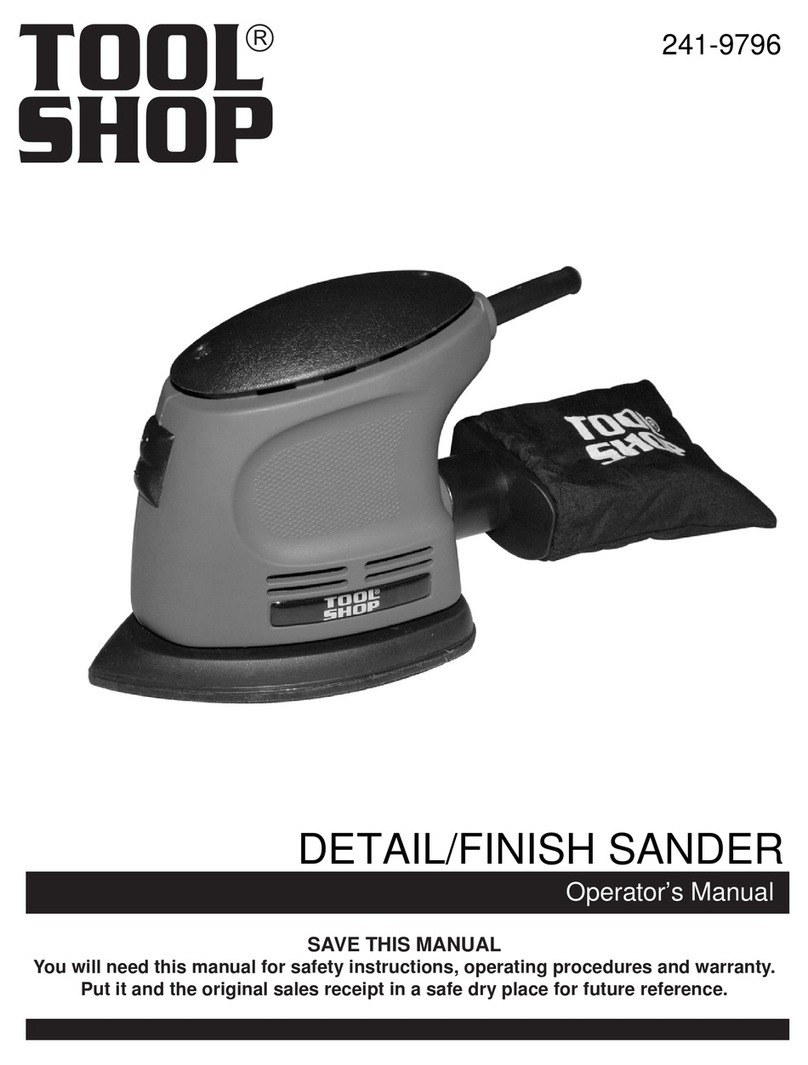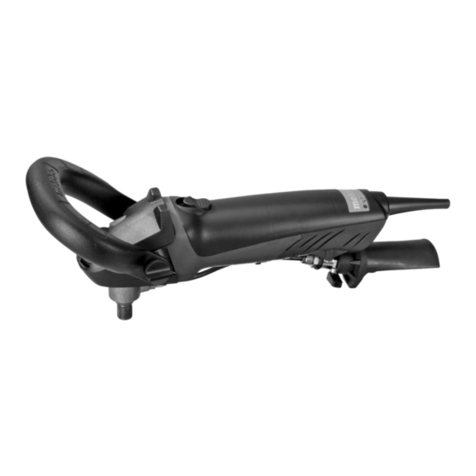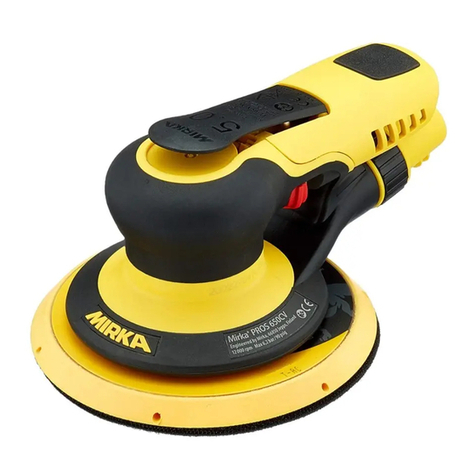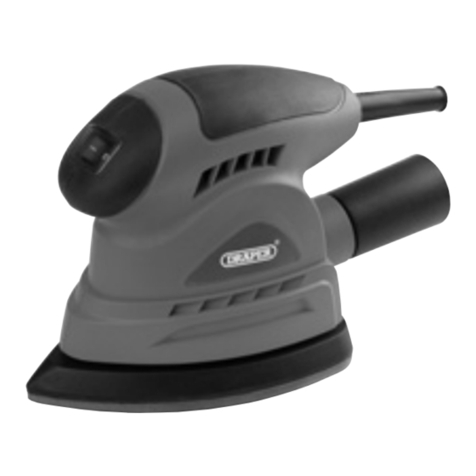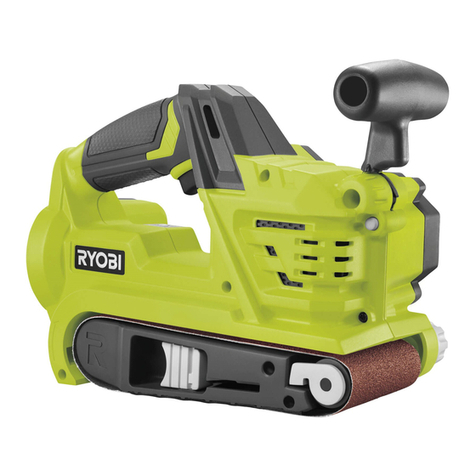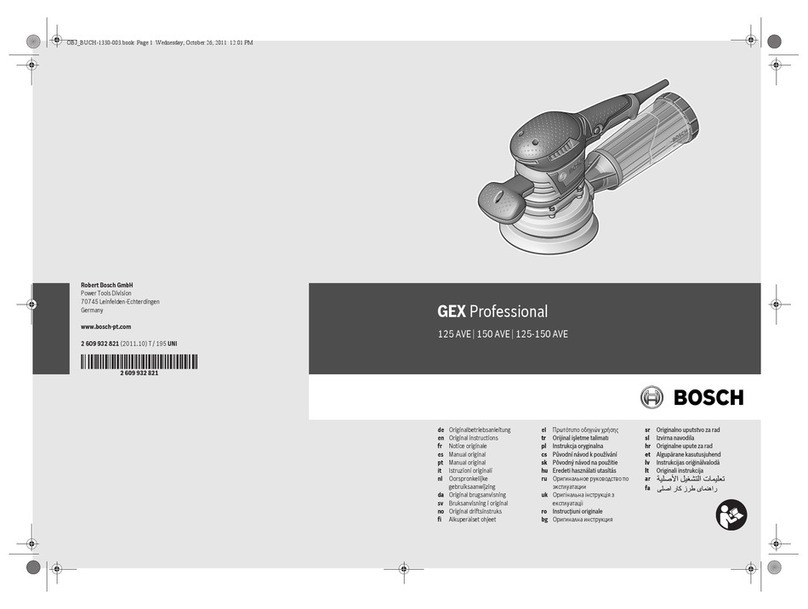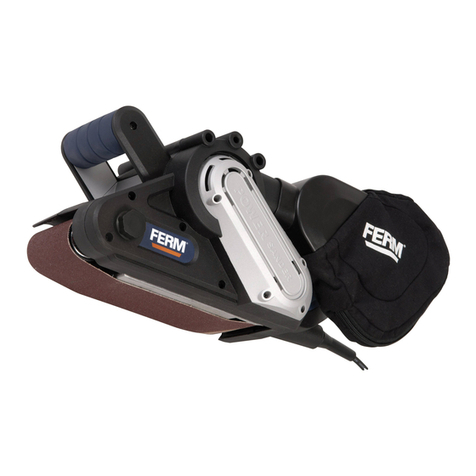Toolshop 241-9946 User manual

1/4 SHEET SANDER
241-9946
Owner’s Manual
PRODUCT SPECIFICATIONS
Rating: 120 V, 60 Hz AC
Amperes: 1.5 A
Speed: 13,000 OPM (no load)
Sanding pad size: 1/4 sheet
Need Assistance?
Call us on our toll free customer support line:
1-866-349-8665
•Technical questions
•Replacement parts
•Parts missing from package

2
Product specifications ………….………………………………………………………………... 1
Table of contents …………………………………………………………………….................. 2
General safety warnings ………………………………………………………………………… 3–4
Eye, ear & lung protection ………………………………………………………………………. 3–4
Electrical safety …………………………………………………………………………………... 4
Power tool safety …………………………………………………………………….................. 5–6
General safety rules ……………………………………………………………………………... 5
Work area ………………………………………………………………….……………………... 5
Electrical safety …………………………………………………………………………………... 5
Personal safety …………………………………………………………………………………... 5–6
Power tool use and care .……………………………………………………………………….. 6
Service ……………………………………………………………………………………………. 6
Specific safety rules ……………………………………………………………………………... 7
Guidelines for extension cords …………………………………………………………………. 8
Symbols …………………………………………………………………………………………… 9
Know your palm sander ……………………………………………………………................... 10
Assembly and operating ………………………………………………………………………… 11–14
Installing the dust bag assembly ……………………………………………………………….. 11
Removing & cleaning the dust bag …………………………………………………………….. 11
Installing sandpaper ……………………………………………………………………………... 11–12
Punching holes in sandpaper …………………………………………………………………... 12
Sandpaper selection …………………………………………………………………………….. 12
ON/OFF switch …………………………………………………………………………………… 13
Sanding …………………………………………………………………………………………… 13–14
Maintenance ……………………………………………………………………………………… 15
Exploded view ……………………………………………………………………………………. 16
Parts list …………………………………………………………………………………………… 17
Warranty ……………………………………………………………………….…………………. 18
TABLE OF CONTENTS

EYE, EAR & LUNG PROTECTION
This instruction manual includes the following:
•General Safety Rules
•Specific Safety Rules and Symbols
•Functional Description
•Assembly
•Operation
•Maintenance
•Accessories
!
ALWAYS WEAR EYE PROTECTION THAT CONFORMS WITH CSA
REQUIREMENTS or ANSI SAFETY STANDARD Z87.1
FLYING DEBRIS can cause permanent eye damage. Prescription
eyeglasses ARE NOT a replacement for proper eye protection.
WARNING: Non-compliant eyewear can cause serious injury if
broken during the operation of a power tool.
WARNING: Use hearing protection, particularly during extended
periods of operation of the tool, or if the operation is noisy.
!
GENERAL SAFETY WARNINGS
WARNING: Before using this tool or any of its accessories, read this
manual and follow all Safety Rules and Operating Instructions. The important
precautions, safeguards and instructions appearing in this manual are not
meant to cover all possible situations. It must be understood that common
sense and caution are factors which cannot be built into the product.
!
SAVE THESE INSTRUCTIONS FOR REFERENCE
3

4
ELECTRICAL SAFETY
GENERAL SAFETY WARNINGS
WEAR A DUST MASK THAT IS DESIGNED TO BE USED WHEN
OPERATING A POWER TOOL IN A DUSTY ENVIRONMENT.
WARNING: Dust that is created by power sanding, sawing, grinding,
drilling, and other construction activities may contain chemicals that are
known to cause cancer, birth defects, or other genetic abnormalities. These
chemicals include:
Lead from lead-based paints
Crystalline silica from bricks, cement, and other masonry products
Arsenic and chromium from chemically treated lumber
The level of risk from exposure to these chemicals varies, according to how
often this type of work is performed. In order to reduce exposure to these
chemicals, work in a well-ventilated area, and use approved safety
equipment, such as a dust mask that is specifically designed to filter out
microscopic particles.
!
WARNING: To avoid electrical hazards, fire hazards or damage to the
tool, use proper circuit protection.
This tool is wired at the factory for 120 V AC operation. It must be
connected to a 120 V AC, 15 A circuit that is protected by a time-delayed
fuse or circuit breaker. To avoid shock or fire, replace power cord
immediately if it is worn, cut or damaged in any way.
SAVE THESE INSTRUCTIONS FOR REFERENCE

5
WARNING:
Read all safety warnings
and instructions. Failure to follow the warnings
and instructions may result in electric shock, fire
and/or serious injury.
Save all warnings and instructions for future
reference.
Work area safety
Keep work area clean and well lit. Cluttered or
dark areas invite accidents.
Do not operate power tools in explosive
atmospheres, such as in the presence of
flammable liquids, gases or dust. Power tools
create sparks which may ignite the dust or
fumes.
Keep children and bystanders away while
operating a power tool. Distractions can cause
you to lose control.
Electrical safety
Power tool plugs must match the outlet.
Never modify the plug in any way. Do not
use any adapter plugs with earthed
(grounded) power tools. Unmodified plugs and
matching outlets will reduce risk of electric
shock.
Avoid body contact with earthed or
grounded surfaces such as pipes, radiators,
ranges and refrigerators. There is an
increased risk of electric shock if your body is
earthed or grounded.
Do not expose power tools to rain or wet
conditions. Water entering a power tool will
increase the risk of electric shock.
Do not abuse the cord. Never use the cord
for carrying, pulling or unplugging the power
tool. Keep cord away from heat, oil, sharp
edges or moving parts. Damaged or
entangled cords increase the risk of electric
shock.
When operating a power tool outdoors, use
an extension cord suitable for outdoor use.
Use of a cord suitable for outdoor use reduces
the risk of electric shock.
If operating a power tool in a damp location
is unavoidable, use a residual current device
(RCD) protected supply. Use of a ground fault
circuit interrupter (GFCI) reduces the risk of
electric shock.
Personal safety
Stay alert, watch what you are doing and use
common sense when operating a power tool.
Do not use a power tool while you are tired
or under the influence of drugs, alcohol or
medication. A moment of inattention while
operating power tools may result in serious
personal injury.
Use personal protective equipment. Always
wear eye protection. Protective equipment
such as dust mask, non-skid safety shoes, hard
hat, or hearing protection used for appropriate
conditions will reduce personal injuries.
Prevent unintentional starting. Ensure the
switch is in the off-position before
connecting to power source and/or battery
pack, picking up or carrying the tool.
Carrying power tools with your finger on the
switch or energizing power tools that have the
switch on invites accidents.
Remove any adjusting key or wrench before
turning the power tool on. A wrench or a key
left attached to a rotating part of the power tool
may result in personal injury.
Do not overreach. Keep proper footing and
balance at all times. This enables better
control of the power tool in unexpected
situations.
Dress properly. Do not wear loose clothing
or jewelry. Keep your hair, clothing and
gloves away from moving parts. Loose
clothes, jewelry or long hair can be caught in
moving parts.
If devices are provided for the connection of
dust extraction and collection facilities,
ensure these are connected and properly
used. Use of dust collection can reduce dust-
related hazards.
POWER TOO
L SAFETY
!

6
PERSONAL SAFETY – cont’d
Power tool use and care
Do not force the power tool. Use the correct
power tool for your application. The correct
power tool will do the job better and safer at the
rate for which it was designed.
Do not use the power tool if the switch does
not turn it on and off. Any power tool that
cannot be controlled with the switch is
dangerous and must be repaired.
Disconnect the plug from the power source
and/or the battery pack from the power tool
before making any adjustments, changing
accessories, or storing power tools. Such
preventive safety measures reduce the risk of
starting the power tool accidentally.
Store idle power tools out of the reach of
children and do not allow persons unfamiliar
with the power tool or these instructions to
operate the power tool. Power tools are
dangerous in the hands of untrained users.
Maintain power tools. Check for
misalignment or binding of moving parts,
breakage of parts and any other condition
that may affect the power tool’s operation. If
damaged, have the power tool repaired
before use. Many accidents are caused by
poorly maintained power tools.
Keep cutting tools sharp and clean. Properly
maintained cutting tools with sharp cutting
edges are less likely to bind and are easier to
control.
Use the power tool, accessories and tool bits
etc. in accordance with these instructions,
taking into account the working conditions
and the work to be performed. Use of the
power tool for operations different from those
intended could result in a hazardous situation.
Service
Have your power tool serviced by a qualified
repair person using only identical
replacement parts. This will ensure that the
safety of the power tool is maintained.
POWER TOOL SAFETY

7
WARNING:
Know your palm sander. Do
not plug in the sander until you have read
and understand this Instruction Manual.
Learn the tool’s applications and limitations,
as well as the specific potential hazards
related to this tool. Following this rule will
reduce the risk of electric shock, fire, or serious
injury.
Always wear eye protection. Any
power tool can throw foreign
objects into your eyes and cause
permanent eye damage.
ALWAYS wear safety goggles (not glasses) that
comply with ANSI safety standard Z87.1.
Everyday glasses have only impact resistant
lenses. They ARE NOT safety glasses.
WARNING:
Glasses or goggles not in
compliance with ANSI Z87.1 could cause
serious injury when they break.
WARNING:
Always use a dust mask
when sanding.
WARNING:
Always use hearing
protection when sanding, particularly during
extended periods of operation.
WARNING:
Always unplug the tool from
the power source before changing the
sandpaper and when cleaning the tool.
Do not wear gloves, neckties or loose clothing.
Secure the workpiece. Use clamps or a vise to
hold the work when practical. It is safer than
using your hand and it frees both hands to
operate the tool.
Do not sand material too small to be securely
held.
Make sure there are no nails or foreign objects
in the part of the workpiece to be sanded.
Always keep hands out of the path of the
sanding pad. Avoid awkward hand positions
where a sudden slip could cause your hand to
move into the path of the sanding pad.
To avoid injury from accidental starting, always
remove the plug from the power source before
installing or removing sandpaper or the vacuum
adaptor.
SPECIFIC SAFETY RULES
SAVE THESE INSTRUCTIONS FOR REFERENCE
!
!
!
!
!

8
Make sure your extension cord is the proper
size. When using an extension cord, be sure to
use one heavy enough to carry the current the
tool will draw. An undersized cord will cause a
drop in line voltage resulting in loss of power
and overheating. The table on at right shows the
correct size to use according to cord length and
nameplate ampere rating. If in doubt, use the
next heavier gauge. The smaller the gauge
number the heavier the cord.
Be sure your extension cord is properly
wired and in good condition. Always replace a
damaged extension cord or have it repaired by a
qualified electrician before using it. Protect your
extension cord from sharp objects, excessive
heat and damp or wet areas.
Use a separate electrical circuit for your
power tools. This circuit must not be less than
14 gauge wire and should be protected with
either a 15A time delay fuse or circuit breaker.
Before connecting the power tool to the power
source, make sure the switch is in the OFF
position and the power source is the same as
indicated on the nameplate. Running at lower
voltage will damage the motor.
WARNING:
Repair or replace damaged
or worn extension cords immediately.
Select the appropriate extension cord gauge
and length using the chart below.
When operating a power tool outdoors, use
an outdoor extension cord marked “W-A” or
“W”. These cords are rated for outdoor use and
reduce the risk of electric shock.
WARNING:
Keep the extension cord
clear of the working area. Position the cord
so it will not get caught on the workpiece,
tools or any other obstructions while you are
working with the power tool.
GUIDELINES FOR EXENSION CORDS
!
MINIMUM GAUGE (AWG) EXTENSION
CORDS (120 V use only)
Ampere rating Total length in feet
More
than
Not
more
than 7.5 m
(25') 15 m
(50') 30 m
(100') 45 m
(150')
0 6 18 16 16 14
6 10 18 16 14 12
10 12 16 16 14 12
12 16 14 12 Not Applicable
!

9
This symbol designates that this tool is
listed with U.S. requirements by
ETL Testing Laboratories, Inc.
Conforms to UL Std. 60745-1 and
60745-2-4.
3042597
JD2585U
V
Volts
A
Amperes
Hz
Hertz
W
Watts
kW
Kilowatts
Microfarads
L
Liters
kg
Kilograms
H
Hours
N/cm
2
Newtons per square
centimeter
Pa
Pascals
OPM
Oscillations per minute
Min
Minutes
S
Seconds
or a.c.
Alternating current
Three-phase alternating
current
Three-phase alternating
current with neutral
Direct current
No load speed
Alternating or direct
current
Class II construction
Splash-proof
construction
Watertight construction
Protective grounding at
grounding terminal,
Class I tools
Revolutions or
reciprocations per
minute
Diameter
Off position
Arrow
Warning symbol
Wear your safety
glasses
SYMBOLS
WARNING:
Some of the following symbols may appear on the palm sander. Study
these symbols and learn their meaning. Proper interpretation of these symbols will
allow for more efficient and safer operation of this tool.
!

10
KNOW YOUR PALM SANDER
Backing
pad
Palm grip
Dust bag
assembly
Sandpaper
clamp
Sandpaper
clamping lever
ON/OFF switch
Cooling
vents
Sandpaper hole
punch
Sandpaper
1 sheet each
#60, 80, 120

11
INSTALLING THE DUST BAG ASSEMBLY
1. Insert the dust duct bag assembly sleeve
(1) into the dust chute (2) (Fig. 1).
NOTE: Make sure the tabs (3) insert into
the matching slots (4) in the dust chute.
2. Rotate the dust chute sleeve CLOCKWISE
approximately 15°to lock it into place.
NOTE: Remove and clean the dust bag
assembly periodically to remove
accumulated dust from the dust bag.
REMOVING & CLEANING THE DUST BAG
1. Remove dust bag assembly by rotating the
dust bag assembly approximately 15°
counter clockwise and pulling it out of the
dust chute in the sander.
2. Remove the dust bag (1) from the dust bag
support (2) by opening the elasticized end
of the dust bag (3) and sliding it off the dust
bag support (Fig. 2).
3. Carefully shake the dust bag with the
elasticized opening pointing downward to
remove the sanding dust.
NOTE: It is best to perform this function
outdoors over a trash can to prevent
sanding dust from escaping into the work
area.
4. Once the sanding dust is removed from the
dust bag, reinstall the dust bag onto the
dust bag support.
5. Reinstall the dust bag assembly into the
dust chute as noted above.
INSTALLING SANDPAPER
WARNING:
Unplug the sander from the
power source before installing or changing
the sandpaper.
1. Lift up and outward on the front and rear
sandpaper clamp levers (1) at the front and
rear of the backing pad (2) (Fig. 3).
2. Insert one end of the ¼ sheet sandpaper
(3) with grit side up into the open front
sandpaper clamp (4), making sure it is
aligned with the backing pad. Lift the
sandpaper clamp lever up and inward to
lock the sandpaper into the clamp.
ASSEMBLY AND
OPERATING
!
Fig. 1
Fig. 2
Fig. 3

12
INSTALLING SANDPAPER – cont’d
3. Wrap the sandpaper sheet (3) over the
backing pad (2) and insert it into the open
rear sandpaper clamp (5) (Fig. 4).
NOTE: Make sure the sandpaper is pulled
tight over the backing pad for proper
sanding operation.
4. Lift the sandpaper clamp lever up and
inward to lock the sandpaper into the
clamp.
PUNCHING HOLES IN SANDPAPER
The sandpaper must have 8 holes punched in it
to allow the sanding dust to escape from the
working surface. The pattern of these holes
must match the hole pattern on the sanding pad.
If the sandpaper you are using does not have
the holes punched, use the hole punch supplied
with the tool to pierce the sandpaper in the
correct locations.
1. Install the sandpaper as shown in
Fig. 3 & 4.
2. Place the hole punch (1) on a sturdy flat
surface (Fig. 5).
3. Align the corner of the sanding pad (2) with
the corner of the hole punch (3). This will
ensure the holes are punched in the
correct location.
4. When the sanding pad is correctly aligned
on the hole punch, press the sanding pad
firmly onto the hole punch.
NOTE: The sharp pegs (4) in the hole
punch will pierce the sandpaper in the
correct location.
SANDPAPER SELECTION
Selecting the correct grit and type of sandpaper
is extremely important in achieving a high
quality sanded finish. Aluminum oxide, silicon
carbide and other synthetic abrasives are best
for power sanding. Natural abrasives such as
flint and garnet are too soft for economical
use in power sanding.
In general, coarse grit will remove the most
material and finer grit will produce the best finish
in all sanding operations. The condition of the
surface to be sanded will determine which grit
will do the best job. If the surface is rough, start
with a coarse grit and sand until the surface is
uniform. Medium grit may then be used to
remove scratches left by the coarser grit. Fine
grit should be used for finishing the surface.
Always continue sanding with each grit until the
surface is uniform.
ASSEMBLY AND OPERATING
Fig. 4
Fig. 5

13
WARNING:
Always wear safety goggles
or safety glasses with side shields when
operating your sander. Failure to do so could
result in foreign objects being thrown into
your eyes resulting in possible serious eye
damage.
Always wear an appropriate dust mask and
hearing protection when using your sander.
ON/OFF SWITCH
To turn the switch ON, press the right hand side
of the ON/OFF switch (1) (Fig. 6). To turn the
switch OFF, press the left hand side of the
ON/OFF switch (2).
SANDING
Clamp or otherwise secure your workpiece to
prevent it from moving under the sander while
being sanded.
WARNING: An unsecured workpiece
could be thrown toward the operator causing
injury.
Place the sander on the workpiece so that the
complete sandpaper surface is in contact with
the workpiece. Turn the sander ON by pressing
on the side of the ON/OFF switch. Move the
sander slowly over workpiece making
successive passes in parallel lines, circles or
crosswise movements. Because the orbital
motion of the sanding pad moves in tiny circles,
it is not necessary to move the sander with the
grain or in the same direction for successive
passes (Fig. 7).
!
For safety reasons, the operator must
read the sections of this Owner’s
Manual entitled "GENERAL SAFETY
WARNINGS", "POWER TOOL SAFETY",
"SPECIFIC SAFETY RULES",
"GUIDELINES FOR EXTENSION
CORDS" and "SYMBOLS" before using
this pad sander.
Verify the following every time the pad
sander is used:
1. Sander cord is not damaged.
2. Safety glasses and dust mask are
being worn.
3. Hearing protection is being worn.
4. Sandpaper is the correct type for
the job.
5. Sandpaper is in good condition and
is properly installed.
Failure to observe these safety rules will
significantly increase the risk of injury.
WARNING
!
ASSEMBLY AND OPERATING
Fig. 6
!
Fig. 7

14
SANDING – cont’d
Upon completion of the sanding operation, turn
the sander OFF by pressing on the opposite
side of the ON/OFF switch. Wait until the
sanding pad comes to a complete stop before
removing it from the workpiece.
WARNING:
Your sander should only be
turned ON when the entire surface of the
sanding pad is in contact with the workpiece.
Failure to follow this sanding procedure
could result in loose sandpaper which could
result in possible injury.
NOTE: Hold the sander using the grip on top
of the sander. Be careful NOT to cover the
motor cooling vents with your hand. Motor
damage may occur from over heating if the
cooling vents are covered.
DO NOT FORCE THE SANDER. The weight of
the sander usually provides adequate pressure.
Let the sander and the sandpaper do the work.
Applying added pressure will slow the motor,
increase the wear on the sandpaper and greatly
reduce the sander speed. Motor damage may
occur if excessive downward pressure is
applied. It will also create an inferior finish on
sanded work. Any finish or resin on wood will
soften from the frictional heat, causing the
sandpaper to become clogged very quickly. Do
not sand in one spot too long as the sander’s
rapid action may remove too much material,
making the surface uneven.
Extended periods of sanding may tend to
overheat the motor. If this occurs, turn sander
OFF, wait until the sanding pad comes to a
complete stop and remove it from the
workpiece. Check to make sure your hand has
not been covering the cooling vents. Let the
motor cool before continuing the sanding
operation.
ASSEMBLY AND OPERATING
!

15
GENERAL
WARNING:
When servicing, use only
identical replacement parts. Use of any other
replacement parts may create a hazard or
cause product damage.
DO NOT use solvents when cleaning plastic
parts. Most plastics are susceptible to damage
from various types of commercial solvents and
may be damaged by their use. Use a clean cloth
to remove dirt, dust, oil, grease etc.
WARNING:
Do not at any time allow
brake fluids, gasoline, petroleum-based
products, penetrating oils, etc. to come in
contact with plastic parts. They contain
chemicals that can damage, weaken or
destroy plastic.
DO NOT abuse power tools. Abusive practices
can damage the tool as well as the workpiece.
WARNING:
DO NOT attempt to modify
tools or create accessories not
recommended. Any such alteration or
modification is misuse and could result in a
hazardous condition leading to possible
serious injury. It will also void the warranty.
It has been found that electric tools are
subjected to accelerated wear and possible
premature failure when they are used on
fiberglass boats and automotive parts,
wallboard, spackling compounds or plaster. The
chips and grindings from these materials are
highly abrasive to electric tool parts such as
bearings, brushes, commutators, etc.
Consequently, it is not recommended that this
tool be used for extended work on any
fiberglass material, wallboard, spackling
compounds or plaster. During any use on these
materials it is extremely important that the tool is
cleaned frequently by blowing the dust out of the
tool with an air jet.
WARNING:
Always wear safety goggles
or safety glasses with side shields during all
sanding operations. It is critical that you also
wear safety goggles or safety glasses with
side shields and a dust mask while blowing
dust out of the sander with an air jet. Failure
to take these safety precautions could result
in permanent eye or lung damage.
LUBRICATION
All of the bearings in this sander are lubricated
with a sufficient amount of high grade lubricant
for the life of the unit under normal conditions.
Therefore, no further lubrication is required.
MAINTENANCE
!
!
!
!

EXPLODED VIEW
16

17
WARNING:
When servicing, use only original equipment replacement parts. The use of any
other parts may create a safety hazard or cause damage to the palm sander.
Any attempt to repair or replace electrical parts on this palm sander may create a safety hazard unless
repairs are performed by a qualified technician. For more information, call the Toll-free Helpline, at
1-866-349-8665.
Always order by PART NUMBER, not by key number.
Key # Part # Part Name Quantity
1 4010010035 Bearing 1
2 3140060001 Rubber dowel 2
3 3140080036 Switch button 1
4 1061250001 Switch 1
5 3150060005 Brush holder 2
6 2030070001 Brush holder support 2
7 1230010120 Carbon brush 2
8 1020080028 Stator 1
9 4010010034 Bearing 1
10 3011080023 Housing (right) 1
11 4030010106 Tapping screw 6
12 1250010002 Wiring terminal 1
13 4030010099 Tapping screw 2
14 3150020001 Strain relief 1
15 3140010054 Cord sleeve 1
16 1190030028 Cord 1
17 1010080028 Rotor 1
18 3150010086 Cooling fan 1
19 2030030206 Balance weight 1
20 2010130033 Eccentricity base 1
21 3140020023 'O'' ring 1
22 3180040011 Dust bag connector 1
23 2050080045 Dust bag support 2
24 6150030011 Dust bag 1
25 4030010099 Tapping screw 2
26 3150110018 Base plate mount 2
27 1160040006 Sandpaper clamp wire 2
28 3190020014 Backing pad 1
29 4030010152 Tapping screw 4
30 3150120071 Base plate 1
31 2030020222 Flat washer 2
32 4040030001 Lock washer 2
33 4030010042 Tapping screw 2
34 4010010055 Bearing 1
35 3180050018 Dust cover 1
36 3160090070 Air deflector 1
37 3011080023 Housing (left) 1
PARTS LIST
!

18
Rev 1.1 26/10/2011
Distributed by: Menard, Inc., Eau Claire, WI 54703
TOOL SHOP
®
¼ SHEET PAD SANDER
WARRANTY
1-YEAR LIMITED WARRANTY:
This
TOOL SHOP
®brand power tool carries a 1-Year Limited Warranty to the
original purchaser. If the tool fails within one (1) year from the date of purchase,
simply bring this tool with your original sales receipt back to your nearest
MENARDS
®retail store. At its discretion,
TOOL SHOP
®agrees to have the
tool replaced with the same or similar
TOOL SHOP
®product free of charge,
within the stated warranty period, when returned by the original purchaser with
original sales receipt. Notwithstanding the foregoing, this limited warranty does
not cover any damage that has resulted from abuse or misuse of the
Merchandise. This warranty: (1) excludes expendable parts including but not
limited to blades, belts, bits, light bulbs, and/or batteries; (2) shall be void if this
tool is used for commercial and/or rental purposes; and (3) does not cover any
losses, injuries to persons/property or costs. This warranty does give you
specific legal rights and you may have other rights, which vary from state to state.
Be careful, tools are dangerous if improperly used or maintained. Seller’s
employees are not qualified to advise you on the use of this Merchandise. Any
oral representation(s) made will not be binding on seller or its employees. The
rights under this limited warranty are to the original purchaser of the Merchandise
and may not be transferred to any subsequent owner. This limited warranty is in
lieu of all warranties, expressed or implied including warranties or merchantability
and fitness for a particular purpose. Seller shall not be liable for any special,
incidental, or consequential damages. The sole exclusive remedy against the
seller will be for the replacement of any defects as provided herein, as long as
the seller is willing or able to replace this product or is willing to refund the
purchase price as provided above. For insurance purposes, seller is not allowed
to demonstrate any of these power tools for you.
For questions / comments, technical assistance or repair parts –
Please call toll free at: 1-866-349-8665 (M-F 8am – 6pm)
SAVE YOUR RECEIPTS. THIS WARRANTY IS VOID WITHOUT THEM.
Table of contents
Other Toolshop Sander manuals
Popular Sander manuals by other brands
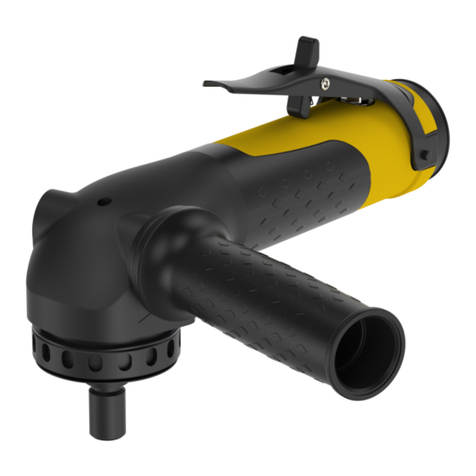
Atlas Copco
Atlas Copco LSV39 S066-M14 Safety information

Makita
Makita BO5040 instruction manual
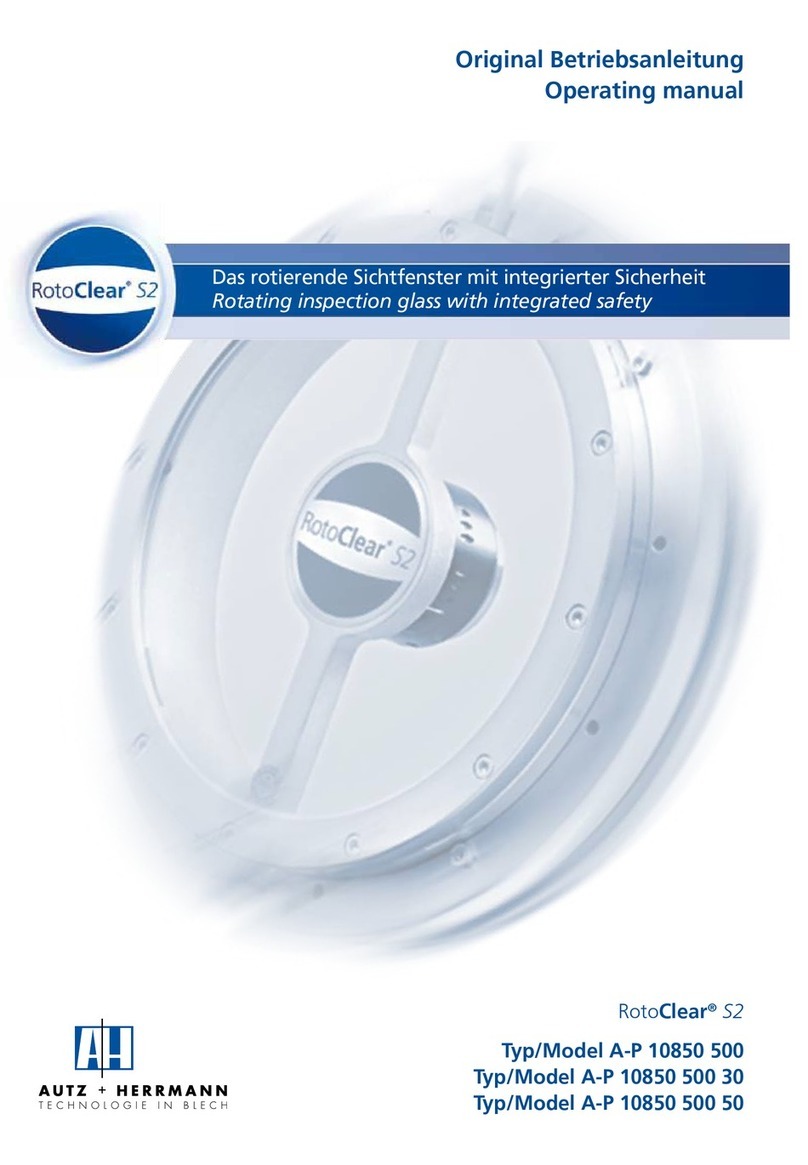
Autz + Herrmann
Autz + Herrmann RotoClear S2 A-P 10850 500 operating manual
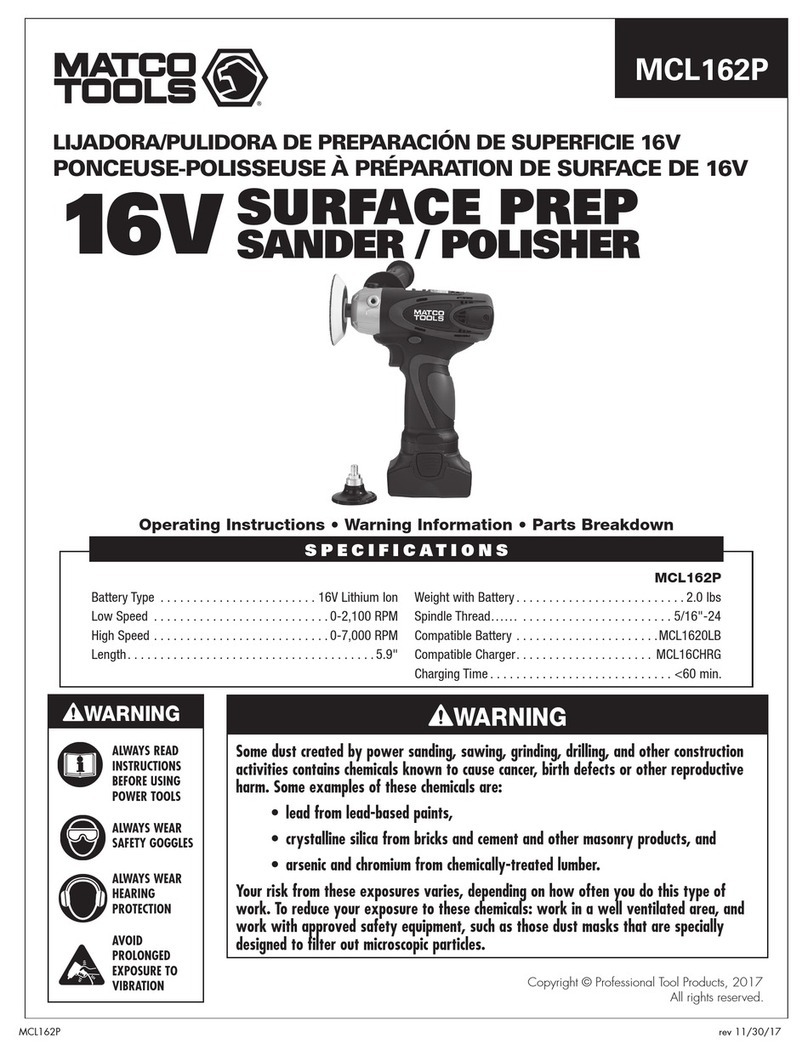
Matco Tools
Matco Tools MCL162P operating instructions
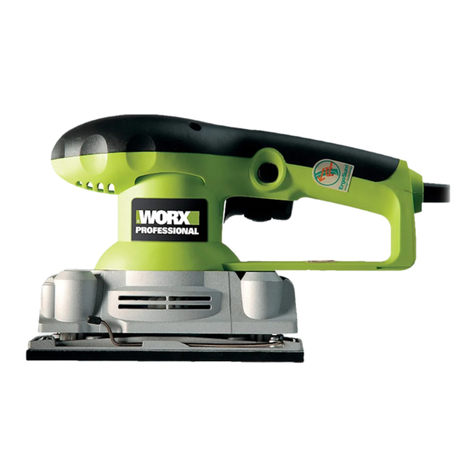
Worx
Worx WU643 manual
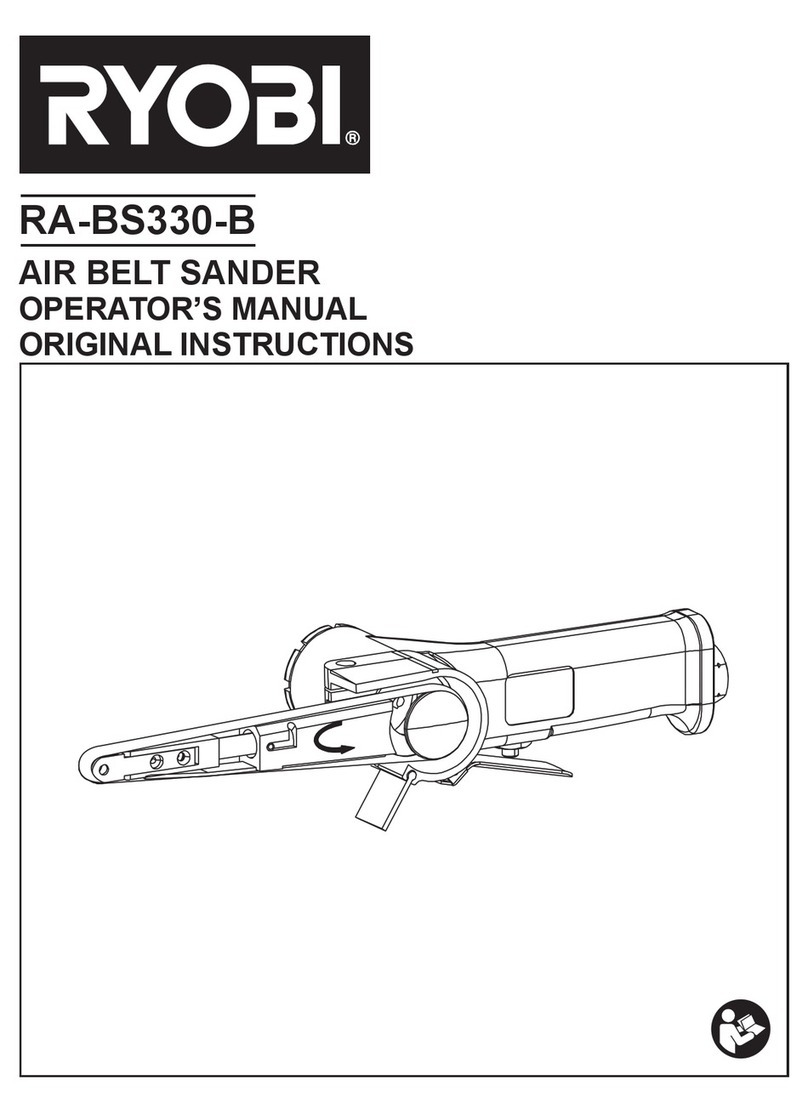
Ryobi
Ryobi RA-BS330-B Operator's Manual Original Instructions
